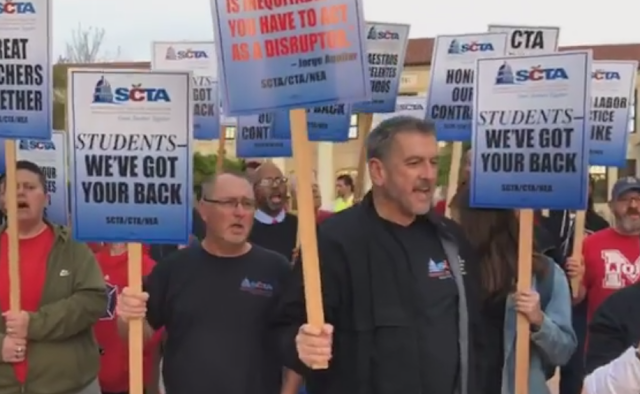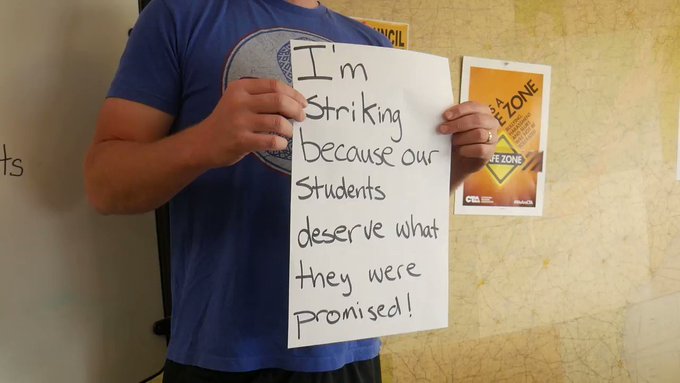Sacramento City Unified teachers walk out for one-day strike | The Sacramento Bee
Hundreds of teachers at Sacramento City Unified walk out on one-day strike
This is a developing news story. Please check back to sacbee.com throughout the day for updates.
Hundreds of teachers across the Sacramento Unified School District walked out of their classrooms and onto picket lines Thursday morning for the first time in 30 years, staging a one-day strike alleging unfair labor practices by the district.
The Sacramento City Teachers Association expected a majority of its 2,500 teachers to join the walkout.
The district, which serves 42,000 students,
told parents in advance that schools would be open and classes would be appropriately staffed. A normal school day was scheduled, with regular attendance monitoring, bus service, meals and programs.
Rosa Parks Elementary School teacher John Brindley greeted his 6th grade students with fist bumps as they walked onto campus Thursday morning, but remained out front with a protest sign rather than join them in the classroom.
“It’s important to stand up for what you believe in. That’s what we’ve been saying to our students,” said Brindley, who has been employed by the district since 2003. “If something is unequal or you think that the things you’ve been told have not been honored, you need to stand up for yourself and make sure that people honor their word.”
Amy Sheehan, a parent of two children at Theodore Judah Elementary School in East Sacramento, brought a megaphone to the picket lines.
“We are out here supporting our teachers,” she said. “As a family, we strongly support union values. We are here to say that standing up for what you believe is right is an important thing to do.”
The strike adds to the extreme pressure faced by Sacramento City Unified, which is under the
threat of state takeover as it attempts to close a $35 million budget gap.
The teachers union, which was on the verge of striking just 18 months ago before
a last-minute deal was brokered that included pay raises, again voted overwhelmingly last month to strike, arguing that the district is not honoring that 2017 agreement. The district maintains it is working with the union to abide by its understanding of the contract.
In a statement released Thursday morning, the teachers union said they were forced to strike, citing unfair labor practices, because the district was not honoring its contract that would reduce class sizes and improve student services.
“SCUSD officials simply need to honor the contract and obey the law,” SCTA president David Fisher said in a statement.
More than 20 teachers stood outside California Middle School at 7:30 a.m., urging motorists passing on Land Park Drive to honk their horns. A similar number turned out at Rosa Parks Elementary, along with some young children holding signs with messages such as “teachers just want to have fund$.”
At McClatchy High School, the largest school in the district, more than 100 teachers took to the picket lines Wednesday morning. Government teacher Lori Jablonski said that group was an overwhelming majority of the school’s educators.
The strike stems from allegations by the teachers union that the district is not honoring its 2017 agreement, including directing savings from a lower quality health plan strictly toward reducing class sizes and funding more health workers and counselors. The union says the district did not reconfirm those funding allocations.
“We have extremely large class sizes,” Jablonski said. “It’s about a 35-to-1 ratio and that’s standard here. We’ve always been on edge.”
Sacramento Mayor Darrell Steinberg — who helped broker the 2017 contract — and district administrators believe the millions in potential health plan savings should go toward alleviating Sacramento City Unified’s $35 million deficit before improving student services. A new health plan has not been agreed upon.
A mediation session Monday between district leaders and the union was unsuccessful, officials said. At a press conference at Success Academy in Meadowview on Thursday morning, Superintendent Jorge Aguilar acknowledged that tensions were running high throughout the district and the city.
“Today we will focus on keeping our schools open, that we provide all the services that our students and their families deserve,” Aguilar said. “But I look forward to tomorrow, to making sure we begin the process of figuring out how we are going to come together, to make sure we put ourselves in the position where we can achieve long term viable fiscal sustainability.”
Some parents opposed the strike, saying that both parties need to come to the table.
The last teacher strike in the district was Sept. 5, 1989, when more than 1,300 teachers and several hundred other certificated workers walked off their jobs on the first day of school to demand higher wages.
The district has until June 20 to balance its budget or face a state takeover.
This is a developing news story. Please check back to sacbee.com throughout the day for updates.





























